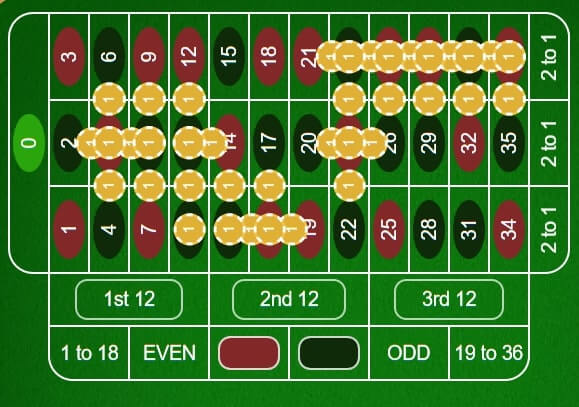Tiers du Cylindre (Series 5/8)
Commonly known simply as “tiers”, tiers du cylindre is a roulette bet that covers about ⅓ of the wheel. In particular, it covers the sector with the following 12 numbers: 27, 13, 36, 11, 30, 8, 23, 10, 5, 24, 16, and 33. We will use these numbers to place 6 split bets. We wager on 1 unit each on 5+8, 10+11, 13+16, 23+24, 27+30, and 30+36.
With 12 numbers in play, we have a 32.43% chance of winning. Any winning number within this sector will earn a profit of 12 units. This is comparable to Columns or Dozens bets which offer a 32.4% chance of netting a 2-unit profit per round. Of course, a loss using this approach will cost 6 units as opposed to the 1-unit net loss for missing a Column or Dozen bet.

| Odds | 32.43% |
|---|---|
| Numbers Covered | 12 |
| Payouts | 12 |
Join the top-rated online roulette casino for beginners!

Putting Tiers du Cylindre to the Test
As we do with every other system we investigate, we will run a simulation to find out how a bankroll should react when a player uses the method over the course of a 1,000-turn session. We used Google Sheets along with the probabilities for each outcome. For this test run, we will give four fictitious players $1,000 each and let them go at it. The results are illustrated in the graph below.

We can see that this method generally has a negative trend to it. We were also able to figure out that every 1,000 rounds will average 676 losses for a loss of 4,056 units. This is offset by the expected 324 wins that earn us a profit of 3,888 units. In other words, we can expect to lose an average of about 168 units during a 1,000-round session. Of course, we can’t ignore how player 3 ended up being profitable, which would indicate that using tiers exclusively during a long session can, in fact, be profitable. Also, it’s interesting to note that most declines happened slowly and all players had periods in which they were in the black.
Tips and Strategies for Using Tiers du Cylindre
One benefit of using such a simple strategy is that you can easily incorporate several other systems and strategies. Let’s go over two of them.
Add Tiers on Top of Straight-up and Split Bets
This might be difficult to do in a live online roulette game simply due to time limits and the sheer number of chips that must be placed on the felt. The idea of this is to achieve maximum coverage. The bottom line is that on top of all the numbers that Tiers covers, add splits and straight-up for all possible combinations. The picture below illustrates this.
However, this comes with a lot more risk. Instead of risking just 5 units, the additional splits and straight-up bets increases our exposure to as much as 38 units. As such, you probably want to avoid this approach if you are playing with a more modest bankroll.

Tiers and d’Alembert
This approach is simple yet effective. In short, we apply the d’Alembert betting strategy to the tier bets. This means we increase our bets by 1 unit following a loss and decrease our bet by a unit following a win. This allows us to quickly recover any losses with less risk than with the Martingale system.
Conclusion
As shown, tiers du cylindre can be a profitable way to bet roulette. This applies to both long and short sessions. This method also opens up a lot of possibilities in terms of integrating other systems with it. For instance, some players simply add 1 unit to the stake amount after a loss and go in the opposite direction after a win. While we combined tiers with d’Alembert, you can always use another betting strategy, such as Martingale, although you might want to avoid doing so if you have a smaller bankroll to work with.
Tiers is simply a group of 6 split bets. While it is a bit reminiscent of Columns and Dozens bets in terms of odds, the payout ratios are marginally higher. Why not try tiers bets? Even better? Why not try mixing tiers bets with other bets and see if you can come up with a system of your own?







